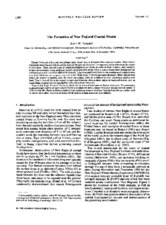| dc.creator | Nielsen, John | |
| dc.date.accessioned | 2016-10-28T17:06:49Z | |
| dc.date.available | 2016-10-28T17:06:49Z | |
| dc.date.issued | 1989 | |
| dc.identifier.citation | Nielsen, J. W., 1989: The formation of New England coastal fronts. Mon. Wea. Rev., 117, 1380-1401. | en |
| dc.identifier.uri | https://hdl.handle.net/1969.1/158210 | |
| dc.description | © Copyright 1989 American Meteorological Society (AMS). Permission to use figures, tables, and brief excerpts from this work in scientific and educational works is hereby granted provided that the source is acknowledged. Any use of material in this work that is determined to be “fair use” under Section 107 of the U.S. Copyright Act September 2010 Page 2 or that satisfies the conditions specified in Section 108 of the U.S. Copyright Act (17 USC §108, as revised by P.L. 94-553) does not require the AMS’s permission. Republication, systematic reproduction, posting in electronic form, such as on a web site or in a searchable database, or other uses of this material, except as exempted by the above statement, requires written permission or a license from the AMS. Additional details are provided in the AMS Copyright Policy, available on the AMS Web site located at (https://www.ametsoc.org/) or from the AMS at 617-227-2425 or copyrights@ametsoc.org. | en |
| dc.description.abstract | Coastal fronts are a frequent late fall and early winter feature of eastern New England weather. Data from a mesoscale observing network is used to describe the process of coastal frontogenesis and to determine the causes of formation. Three distinct types of coastal frontogenesis are found to occur in New England, and examples of each are presented using mesoscale surface maps and time series. Type a coastal fronts form during cold air outbreaks as winds veer from offshore to onshore. Type B coastal fronts form in the evening as air temperatures over land fall below air temperatures over water. Both types of fronts represent thermally direct circulations which are created by heating from the warm sea surface, often in combination with radiational cooling over land. Type C coastal fronts are caused by upstream blocking when a stable region of warm advection, such as warm front, approaches the Appalachian Mountains from the south.
Type A and Type B fronts are described in terms of land and sea breeze dynamics. The persistent, quasi-stationary nature of such coastal fronts is investigated with a simple two-layer density current model. It is found that the effects on frontal motion of an increasing onshore wind and heating from the sea surface tend to cancel each other, resulting in fronts which tend to remain stationery just offshore. | en |
| dc.description.sponsorship | National Science Foundation | en |
| dc.language.iso | en_US | |
| dc.publisher | American Meteorological Society | |
| dc.subject | coastal fronts | en |
| dc.subject | thermal circulations | en |
| dc.title | The formation of New England coastal fronts | en |
| dc.type | Article | en |
| local.department | Atmospheric Sciences | en |
| dc.identifier.doi | 10.1175/1520-0493(1989)117<1380:TFONEC>2.0.CO;2 | |


